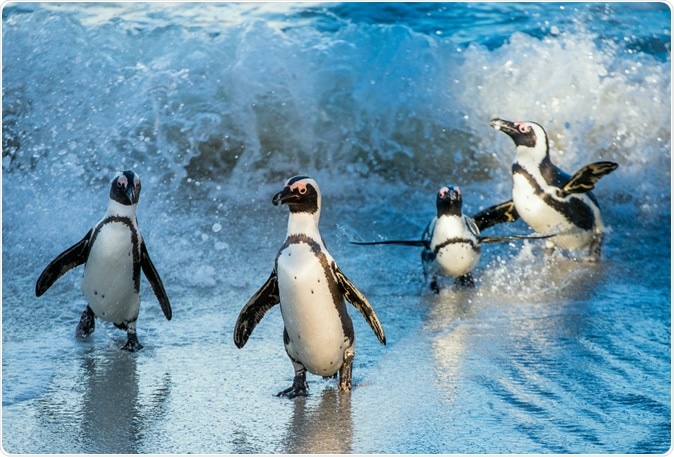The jackass penguin makes a noise like its namesake, but the way it uses sounds to convey messages is somewhat like the laws of human speech, says a new study published in February 2020 in the journal Biology Letters.

African penguin ( Spheniscus demersus) also known as the jackass penguin and black-footed penguin. Boulders colony. South Africa. Image Credit: Sergey Uryadnikov
The similarities include the use of shorter sounds more frequently, and the way a longer call is composed of shorter sounds compared to shorter calls. This pattern is characteristic of primate ‘talk’ but has been seen in non-primate species for the first time with this study.
Yet it is unlikely to be unique, says researcher Livio Favaro, who predicts, “We can probably find many other species that conform to these laws because this is probably a general principle, rather than something related to human language specifically.”
Other experts concur, such as primate communication expert Stuart Semple, who says animals should be expected to use communication efficiently. This mode of information transfer, called compression, is seen also in systems like the Morse code which uses the shortest and simplest signals, that is, a dot or a dash, to represent the letters in most common use.
Semple observes, “If you have compression in the communication system it is more efficient. Animals that communicate efficiently are expending less energy.”
The study
The researchers used 590 recorded calls by 28 adult African or jackass penguins living in 3 separate colonies in various zoos in Italy. All the calls, or vocalizations, as scientists call them, fell in the category of “ecstatic display songs”, that is, male calls made in mating season, intended to identify the calling bird, proclaim the bird’s claim to territory, and help the bird to win a mate.
These calls have three different types of sounds or syllables found in sequence.
The findings
The team found that penguin display songs follow two basic laws found in human communication, namely, Zipf’s law of brevity and the Menzerath-Altmann law.
Zipf’s law states that sounds used more often in a language tend to be shorter, while the second says that longer language units (for instance, longer words in English) tend to be made up of shorter sounds (compare the complex-sound single-syllable word “strength” with the simple-sounding polysyllabic word “parameterise”). This example was cited by linguist Chris Kello who specializes in discovering language patterns.
The study says, “This is the first compelling evidence for conformity to linguistic laws in vocal sequences of a non-primate species. As predicted, we found that the duration of the syllables was inversely correlated with the frequency of occurrence.”
Implications
The researchers think their findings show that the laws of language are not just or primarily about language as such, but about language as a means of communicating information. The fact that the laws followed by penguin calls have nothing to do with semantics (the meaning of language) or syntax (the grammatical structure of language) shows, they say, that their basic purpose is to share information with maximum efficiency. In addition, the use of language is shaped by other needs as well, such as, in this case, the need to convey the penguin’s size and identity, even while maintaining a high level of efficiency.
Kello observes that the linguistic laws discovered to hold good in penguin calls were first revealed through the study of text. As a result, they were long thought to be the result of the symbolic purpose of human language. This study, along with earlier ones, shows, he says, “that the laws are physical and not symbolic, because even penguins show them. Instead, the laws seem to reflect something deeper and more general about communication and information.” The environment of most animals demands quick and effective communication, and animal as well as human communication is geared to these requirements, making them fundamental to language structure.
In the case of the current study, the researchers conclude, “We suggest that relationships between element duration, frequency of use and song size are mainly a consequence of vocal production constraints interacting with selective pressures for intersexual mate choice and territorial defence in dense colonies. Importantly, our results suggest for the first time that information compression can coexist with other sources of selection in a non-primate species with a small and relatively fixed vocal system.”
The African Penguin Bray - Sounds Of The Aquarium
Journal reference:
Do penguins’ vocal sequences conform to linguistic laws? Livio Favaro, Marco Gamba, Eleonora Cresta, Elena Fumagalli, Francesca Bandoli, Cristina Pilenga, Valentina Isaja, Nicolas Mathevon and David Reby Published:05 February 2020, https://doi.org/10.1098/rsbl.2019.0589